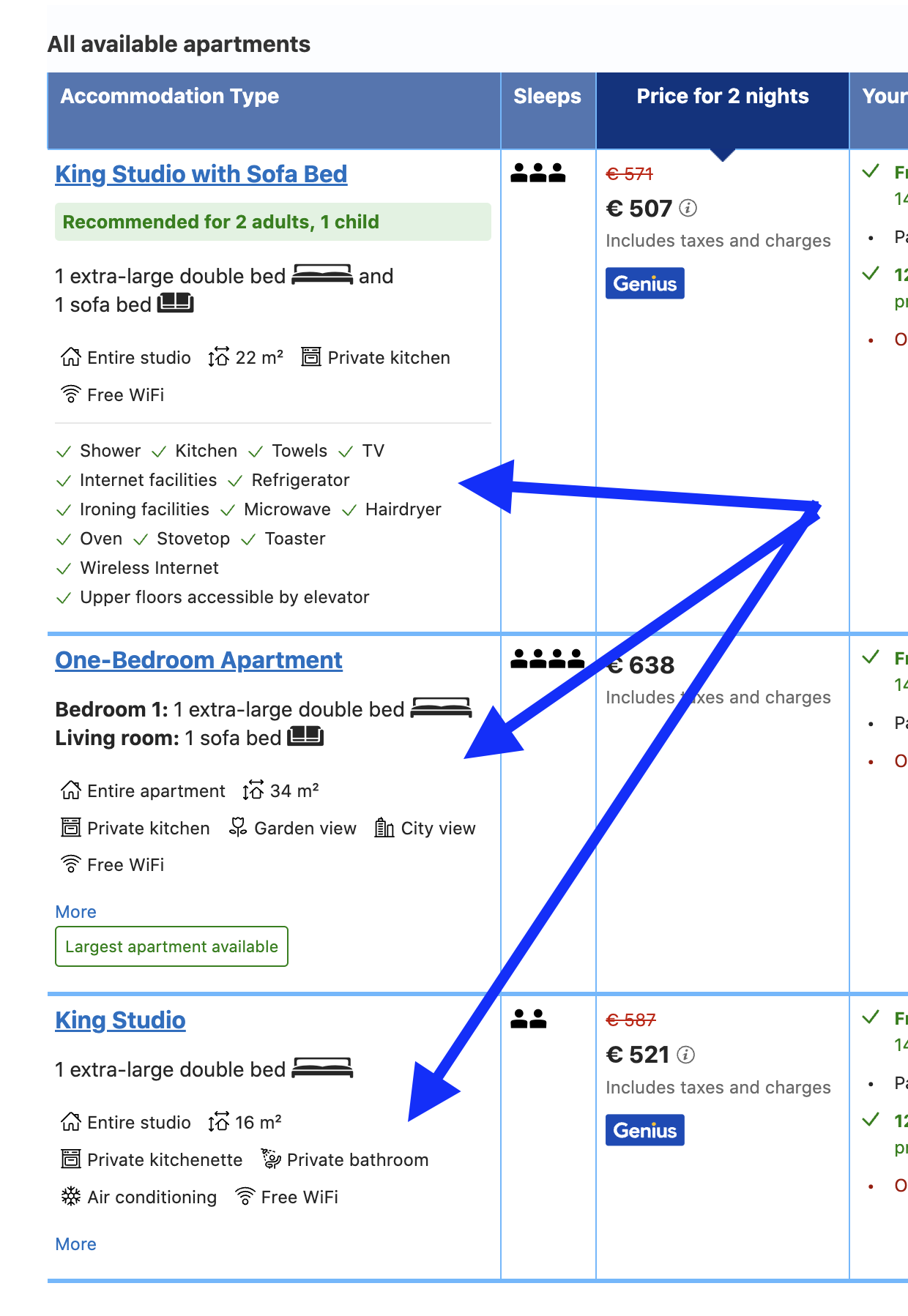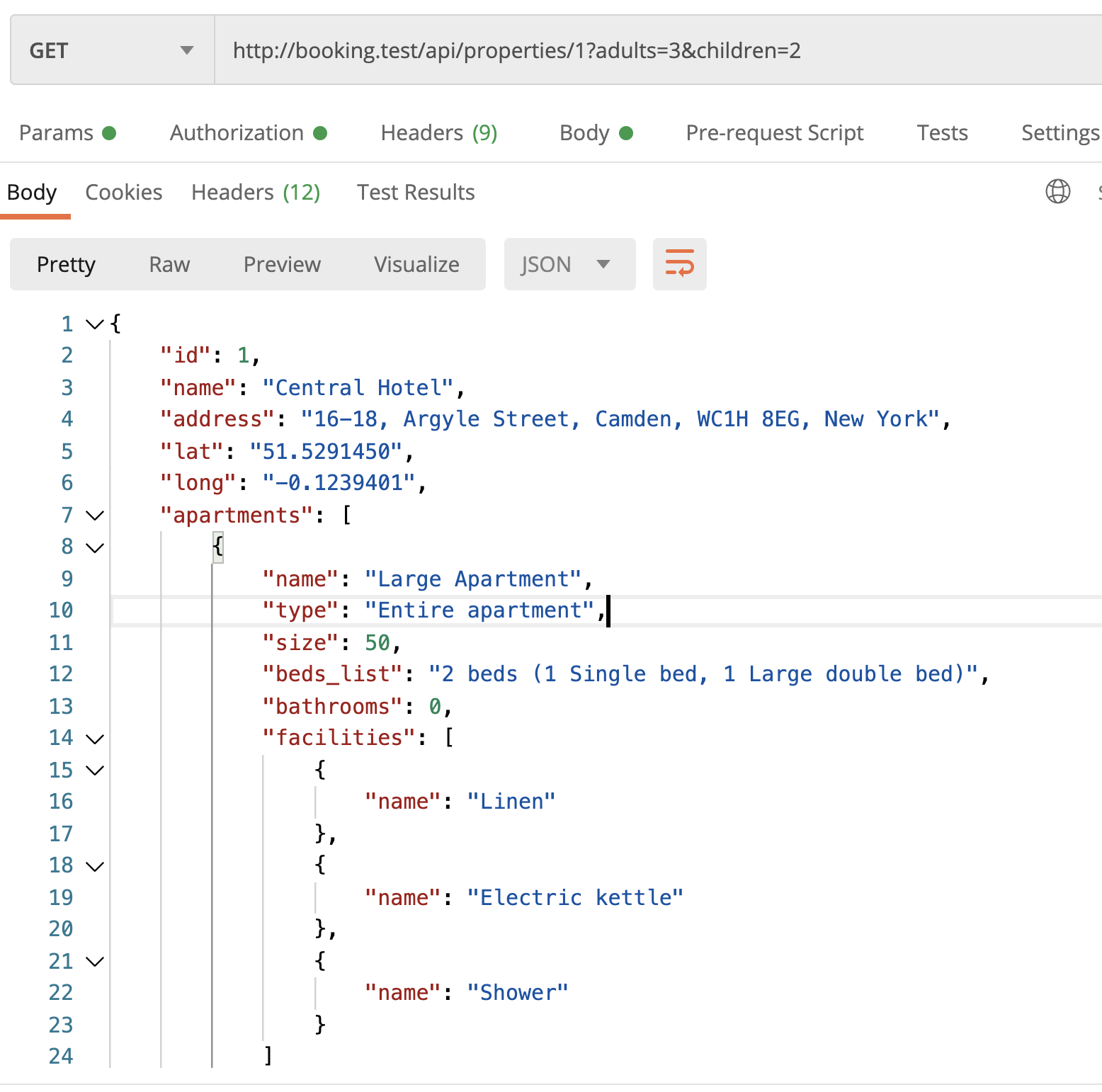Now imagine the user clicking on the property to choose the apartment. Inside the property view, we need to show the full list of available apartments, with their facilities:

The Facility model will be a new thing in this lesson.
Goals of This Lesson
- Build Facility DB/relationship structure
- Show facilities in the new Show Property endpoint
By the end of this lesson, we will have this list of facilities showing in Postman:

Facilities: DB Structure
An obvious question: what are those facilities, and what are the different options and categories for them? There could be dozens or even hundreds of various facilities.
I've found the answer to this question while browsing the mobile version of Booking.com, which showed the apartment facilities in a well-structured way:

So I imagine structuring something like this:
facility_categories:
- id
- name
facilities
- id
- category_id
- name
apartment_facility
- apartment_id
- facility_id
Let's create exactly that.
php artisan make:model FacilityCategory -msNotice that I generate the model with seeder this time, with a flag -s.
Migration file:
public function up(): void{ Schema::create('facility_categories', function (Blueprint $table) { $table->id(); $table->string('name'); $table->timestamps(); });}app/Models/FacilityCategory.php:
class FacilityCategory extends Model{ use HasFactory; protected $fillable = ['name'];}And let's add the categories for the seeder. This time, different from other lessons, I will do that in a separate seeder, cause that list is likely to change in the future, not so static.
database/seeders/FacilityCategorySeeder.php:
namespace Database\Seeders; use App\Models\FacilityCategory; class FacilityCategorySeeder extends Seeder{ public function run(): void { FacilityCategory::create(['name' => 'Bedroom']); FacilityCategory::create(['name' => 'Kitchen']); FacilityCategory::create(['name' => 'Bathroom']); FacilityCategory::create(['name' => 'Room Amenities']); FacilityCategory::create(['name' => 'General']); FacilityCategory::create(['name' => 'Media & Technology']); }}Same with Facilities.
php artisan make:model Facility -msMigration file:
public function up(): void{ Schema::create('facilities', function (Blueprint $table) { $table->id(); $table->foreignId('category_id') ->nullable() ->references('id') ->on('facility_categories'); $table->string('name'); $table->timestamps(); });}Notice that I specify nullable() this time, just in case - maybe there will be a separate facility without categories.
Also, instead of constrained(), I specify references()->on(), because the table name is not categories, as the default facilities.category_id field name would expect.
app/Models/Facility.php:
class Facility extends Model{ use HasFactory; protected $fillable = ['category_id', 'name']; public function category() { return $this->belongsTo(FacilityCategory::class, 'category_id'); }}Also, I think it's logical to create a hasMany() relationship right away, as I feel we will use it in the lists.
app/Models/FacilityCategory.php:
class FacilityCategory extends Model{ // ... public function facilities() { return $this->hasMany(Facility::class, 'category_id'); }}Similarly, let's seed a few facilities, I will take them from the same mobile screenshot above.
database/seeders/FacilitySeeder.php:
use App\Models\Facility; class FacilitySeeder extends Seeder{ public function run(): void { Facility::create(['category_id' => 1, 'name' => 'Linen']); Facility::create(['category_id' => 1, 'name' => 'Wardrobe or closet']); Facility::create(['category_id' => 2, 'name' => 'Electric kettle']); Facility::create(['category_id' => 2, 'name' => 'Microwave']); Facility::create(['category_id' => 2, 'name' => 'Washing mashine']); Facility::create(['category_id' => 3, 'name' => 'Private bathroom']); Facility::create(['category_id' => 3, 'name' => 'Shower']); Facility::create(['category_id' => 3, 'name' => 'Towels']); Facility::create(['category_id' => 4, 'name' => 'Drying rack for clothing']); Facility::create(['category_id' => 5, 'name' => 'No smoking']); Facility::create(['category_id' => 5, 'name' => 'Fan']); Facility::create(['category_id' => 6, 'name' => 'WiFi']); Facility::create(['category_id' => 6, 'name' => 'TV']); }}Finally, I add both new Seeder files into the main one.
database/seeders/DatabaseSeeder.php:
class DatabaseSeeder extends Seeder{ public function run() { $this->call(RoleSeeder::class); $this->call(AdminUserSeeder::class); $this->call(PermissionSeeder::class); $this->call(CountrySeeder::class); $this->call(CitySeeder::class); $this->call(GeoobjectSeeder::class); $this->call(FacilityCategorySeeder::class); $this->call(FacilitySeeder::class); }}So, we have the structure for the facilities and categories, now let's attach them to the Apartments, with a many-to-many pivot table.
php artisan make:migration create_apartment_facility_tableMigration file:
public function up(): void{ Schema::create('apartment_facility', function (Blueprint $table) { $table->foreignId('apartment_id')->constrained(); $table->foreignId('facility_id')->constrained(); });}And let's add a relationship: for now, from the apartment side.
app/Models/Apartment.php:
class Apartment extends Model{ // ... public function facilities() { return $this->belongsToMany(Facility::class); }}Ok great, now we have the data. Next, how do we show that data?
Property: Show Apartments with Facilities
Let's get back to the initial screenshot from Booking.com, at the beginning of this lesson. I will repeat it here.

This is the page that you get after clicking on a specific property from the search result. We don't have that endpoint yet, so let's create it.
It will be a new controller, a public one, to show property details.
php artisan make:controller Public/PropertyController --invokableSimilarly to Search, it will be an invokable Controller, with only one method. The difference here is that we will use Route Model Binding to pass properties.id as a parameter.
And, for now, let's just try to re-use the same API Resource of Search to return the response.
app/Http/Controllers/Public/PropertyController.php:
namespace App\Http\Controllers\Public; use App\Http\Controllers\Controller;use App\Http\Resources\PropertySearchResource;use App\Models\Property;use Illuminate\Http\Request;use Illuminate\Http\Response; class PropertyController extends Controller{ public function __invoke(Property $property, Request $request): Response { return new PropertySearchResource($property); }}Next, let's build the API route for this:
routes/api.php:
Route::get('search', \App\Http\Controllers\Public\PropertySearchController::class);Route::get('properties/{property}', \App\Http\Controllers\Public\PropertyController::class);And if we launch it in Postman, the result is this:

Success! Simple, right?
But not so fast, we need to make one tweak here: show only suitable apartments from the search.
We do need to still pass the same parameters of search like adults and children. If you searched, you would like the same search query to remain inside the property page, right?
So, here's where our Request $request parameter comes in, we filter and order the property apartments in a similar way, like in search.
app/Http/Controllers/Public/PropertyController.php:
public function __invoke(Property $property, Request $request){ if ($request->adults && $request->children) { $property->load(['apartments' => function ($query) use ($request) { $query->where('capacity_adults', '>=', $request->adults) ->where('capacity_children', '>=', $request->children) ->orderBy('capacity_adults') ->orderBy('capacity_children'); }]); } return new PropertySearchResource($property);}Here, we use ->load() instead of ->withWhereHas() because we don't need to search anymore, we already know that property is suitable, and we have its object in $property, so we just need to load the relationship, which isn't loaded by default with route model binding.
Now, we can call this API endpoint like this: /api/properties/1?adults=3&children=2.
Next, we get to show the main topic of this lesson: showing facilities.
Of course, we can load them with the relationship, right?
But first, to show the facilities, let's create their own API Resource:
php artisan make:resource FacilityResourceFor now, let's just show the name of the facility.
app/Http/Resources/FacilityResource.php:
class FacilityResource extends JsonResource{ public function toArray(Request $request): array { return [ 'name' => $this->name, ]; }}Then, we load that FacilityResource as a part of another ApartmentSearchResource:
app/Http/Resources/ApartmentSearchResource.php:
class ApartmentSearchResource extends JsonResource{ public function toArray(Request $request): array { return [ 'name' => $this->name, 'type' => $this->apartment_type?->name, 'size' => $this->size, 'beds_list' => $this->beds_list, 'bathrooms' => $this->bathrooms, 'facilities' => FacilityResource::collection($this->whenLoaded('facilities')), ]; }}See that $this->whenLoaded()? It means that it will show the facilities field only if it's eager-loaded from the Controller. This is a performance optimization to avoid too many queries and loading too much unneeded data.
So this is exactly what we'll do in Controller.
app/Http/Controllers/Public/PropertyController.php:
class PropertyController extends Controller{ public function __invoke(Property $property, Request $request) { $property->load('apartments.facilities'); if ($request->adults && $request->children) { $property->load(['apartments' => function ($query) use ($request) { $query->where('capacity_adults', '>=', $request->adults) ->where('capacity_children', '>=', $request->children) ->orderBy('capacity_adults') ->orderBy('capacity_children'); }]); } return new PropertySearchResource($property); }}So we're loading facilities all the time, and if there are adult/children parameters, we override the value of apartments and filter them.
Notice: perhaps there's a way to filter the results with Collection instead of doing $property->load() but during my experiments, I didn't manage to make the Collection filter/reject methods work correctly.
Result in Postman:

Hooray, we see the list of facilities!
Now, let's write automated tests for this. We need to check a few things:
- Property endpoint works and loads the correct property
- It works with or without adult/children parameters
- It loads the facilities correctly
- It doesn't load the facilities in the Search
php artisan make:test PropertyShowTesttests/Feature/PropertyShowTest.php:
namespace Tests\Feature; use App\Models\Apartment;use App\Models\City;use App\Models\Facility;use App\Models\FacilityCategory;use App\Models\Property;use App\Models\Role;use App\Models\User;use Illuminate\Foundation\Testing\RefreshDatabase;use Illuminate\Foundation\Testing\WithFaker;use Tests\TestCase; class PropertyShowTest extends TestCase{ use RefreshDatabase; public function test_property_show_loads_property_correctly() { $owner = User::factory()->create(['role_id' => Role::ROLE_OWNER]); $cityId = City::value('id'); $property = Property::factory()->create([ 'owner_id' => $owner->id, 'city_id' => $cityId, ]); $largeApartment = Apartment::factory()->create([ 'name' => 'Large apartment', 'property_id' => $property->id, 'capacity_adults' => 3, 'capacity_children' => 2, ]); $midSizeApartment = Apartment::factory()->create([ 'name' => 'Mid size apartment', 'property_id' => $property->id, 'capacity_adults' => 2, 'capacity_children' => 1, ]); $smallApartment = Apartment::factory()->create([ 'name' => 'Small apartment', 'property_id' => $property->id, 'capacity_adults' => 1, 'capacity_children' => 0, ]); $facilityCategory = FacilityCategory::create([ 'name' => 'Some category' ]); $facility = Facility::create([ 'category_id' => $facilityCategory->id, 'name' => 'Some facility' ]); $midSizeApartment->facilities()->attach($facility->id); $response = $this->getJson('/api/properties/'.$property->id); $response->assertStatus(200); $response->assertJsonCount(3, 'apartments'); $response->assertJsonPath('name', $property->name); $response = $this->getJson('/api/properties/'.$property->id.'?adults=2&children=1'); $response->assertStatus(200); $response->assertJsonCount(2, 'apartments'); $response->assertJsonPath('name', $property->name); $response->assertJsonPath('apartments.0.facilities.0.name', $facility->name); $response->assertJsonCount(0, 'apartments.1.facilities'); $response = $this->getJson('/api/search?city=' . $cityId . '&adults=2&children=1'); $response->assertStatus(200); $response->assertJsonPath('0.apartments.0.facilities', NULL); }}We're making two API requests: with and without adult/children parameters.
Notice specifically the last lines: we're testing that facilities are shown correctly in the JSON result for both the property endpoint and in search result.
Are you sure this about this line?
From what I remember in my testing yes it was NULL. Can you explain your thought why this is wrong?
Sorry, You right, the test comes success
I have carefully read the guide you published on property listings and I have a question regarding the invoke method in the PropertyController. In the section where data is loaded using the load method, I noticed that the load method is called twice for the apartments.facilities relationship. I'm wondering why it is necessary to reload the relationship at this stage, as it seems that the relationship is already included in the $property object in the first load('apartments.facilities') call. Could you please explain why a second load of the same relationship is being performed?
I read in the guide that it mentions overriding the values of apartments, but I'm not clear on how this is connected to the second load of the relationship. Could you kindly provide further details on this point?**
You're probably right, we don't need to load it the second time. I will update the tutorial, great catch!
When setup migration for facilities table, the reason why u re using references('id')->on('facility_categories') instead of using constrained because the table name is not categories. But we can use constrained function and put the table name as first argument like constrained('facility_categories', 'id'), can't we?
Sir, firstly thankyou for this tutorial i'm learning a lot. I followed this guide until i found an error on PropertyShowTest in part :
the error message is "property show loads property correctly. Failed asserting that null is identical to 'Some Facility" i try to debug using dd($response->json()). i notice the facilities field is not exist Although i already load the apartments.facilities relationship on the PropertyController. But when i change $this->whenLoaded('facilities') to $this->facilities (on ApartmentSearchResource), the facilities field exists and the test passes. I spend hours trying to solve this but still no solution yet. Could u help me to solve this? Or what im missing? Thanks
To be honest, I don't remember now as the course has been created a few months ago, and I can't "blindly" debug your situation. Could you please compare your code to the official repository and maybe see what you're missing? Or maybe the error is in the official repository, too? Then let me know. Thanks!
Hi, the problem is when you filter by adults and children in the controller, you only load facilities relationship when you don't send query params.
In the guide, the code is this:
But if you add the facilities relationship into query params, all test pass.
Wow thank you that solve the issue, much appreciated